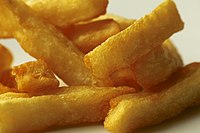Triple-cooked chips
 | |
| Course | Appetizer, side dish |
|---|---|
| Place of origin | England |
| Created by | Heston Blumenthal |
| Serving temperature | Hot |
| Main ingredients | Potato |
Triple-cooked chips are a type of chips or deep-fried potato that were developed by English chef Heston Blumenthal. Blumenthal began work upon the recipe in 1993, and eventually developed the three-stage cooking process for their preparation. The preparation process involves the chips first being simmered and then cooled and drained of water using a sous-vide technique or by freezing, deep fried at 130 °C (266 °F) and again cooled, and finally deep fried again at 180 °C (356 °F) The result is what Blumenthal calls "chips with a glass-like crust and a soft, fluffy centre".[1]
History
Blumenthal said he was "obsessed with the idea of the perfect chip",[2] and described how, from 1992 onwards, he worked on a method for making "chips with a glass-like crust and a soft, fluffy centre".[1]
He researched the starch content of different varieties of potato[2] and experimented with drying chips by microwaving, desiccating or even individually pinpricking them.[1] Eventually Blumenthal developed the three-stage cooking process generally known as triple-cooked chips, which he identifies as "the first recipe I could call my own".[1]
Preparation
Blumenthal's technique
Previously, the traditional practice for cooking chips was a two-stage process, in which chipped potatoes were fried in oil first at a relatively low temperature to soften them and then at a higher temperature to crisp up the outside. Heston's recipe involves simmering the potatoes first in water[3] for 20–30 minutes until they are almost falling apart and have developed lots of little cracks across the surface,[4] at which point they are drained and as much moisture as possible is expelled by placing them in either a freezer[5] or desiccator machine. This additional stage is designed to achieve three objectives. First, cooking the potatoes gently in water helps ensure they acquire a properly soft texture. Second, the cracks that develop in the chips provide places for oil to collect and harden during frying, making them crunchy.[6] Third, thoroughly drying out the chips drives off moisture that would otherwise keep the crust from becoming crisp. Blumenthal describes moisture as the "enemy" of crisp chips.[6]
The second of the three stages is frying the chips at 130 °C (266 °F)[5] for approximately 5 minutes, after which they are cooled once more in a freezer or sous-vide machine before the third and final stage: frying at 180 °C (356 °F)[5] for approximately 7 minutes until crunchy and golden. The second stage of low-temperature frying is as essential as the first, according to Heston, as it makes "any starch left in the surface cells dissolve and combine to create a rigid outer layer that can withstand the higher temperature of the final frying".[6] This second stage is time-consuming, he acknowledges, but must not be omitted. "A single frying at a high temperature leads to a thin crust that can easily be rendered soggy by whatever moisture remains in the chip’s interior."[6]
Other chefs, such as Joël Robuchon, had previously[verification needed] used such a method of cooking chips in simmering water before subjecting them to a two-stage frying.[7]
Variations

Variations include using a refrigerator to cool the chips in between cooking times and the use of different temperatures, such as 140 °C (284 °F) for the first cooking and 200 °C (392 °F) for the second.[4] Triple Cooked Chips cooked in duck fat is another variation. Various cultivars of potato are used, such as sebago,[4] Rooster and Maris Piper.[8]
Popularity
First served at The Fat Duck in 1995, triple-cooked chips have since become a standard feature in restaurants.[citation needed]
Reception
The Sunday Times described Blumenthal's dish as "arguably his most influential culinary innovation", and felt that it gave the chip "a whole new lease of life".[8]
See also
- List of deep fried foods
- List of potato dishes
- List of twice-baked foods
- Pommes soufflées – a variety of French fried potato. Slices of potato are fried twice, once at 150 °C (300 °F) and then again after cooling, at 190 °C (375 °F).[9]
References
- ^ a b c d Blumenthal, The Big Fat Duck Cookbook
- ^ a b Blumenthal, In Search of Perfection
- ^ Fort, Matthew (29 April 2011). "Food for Fort: The quest for the perfect chip". The Guardian. Retrieved 17 June 2014.
- ^ a b c Moran, Matt (20 November 2011). "Matt Moran makes Heston Blumenthal's triple-cooked chips". The Daily Telegraph. Retrieved 17 June 2014.
- ^ a b c Stewart, Victoria (29 May 2013). "Hot chips: the 50 best chips in London". London Evening Standard. Retrieved 17 June 2014.
- ^ a b c d Blumenthal, Heston Blumenthal at Home
- ^ Jeffrey Steingarten, The Man Who Ate Everything (New York: Vintage Books, 1998), 409
- ^ a b Heston Blumenthal (2013-11-17). "Triple-cooked chips, by Heston Blumenthal". The Sunday Times. Retrieved 2014-06-17.
- ^ "Pommes soufflées". Saveur-Bonner Corporation. 2009. Retrieved 2009-06-20.
Bibliography
- Blumenthal, Heston (2006). In Search of Perfection. Bloomsbury Publishing. ISBN 0747584095
- Blumenthal, Heston (2008). The Big Fat Duck Cookbook. Bloomsbury Publishing Plc. ISBN 0747583692
- Blumenthal, Heston (2011). Heston Blumenthal at Home. Bloomsbury. ISBN 1408804409
Further reading
- Sanghvi, Vir (17 June 2011). "French fries: Holy Grail of cooking". Hindustan Times. Retrieved 17 June 2014.
- "Triple Cooked Chips Recipe". Channel 4. Retrieved 17 June 2014.
External links
- Triple-Cooked Chips. Epicurious.
- Heston's Triple Cooked Chips. Great British Chefs.
- Fillet Steak with Triple Cooked Chips and Bearnaise Sauce. Lifestyle Food.
